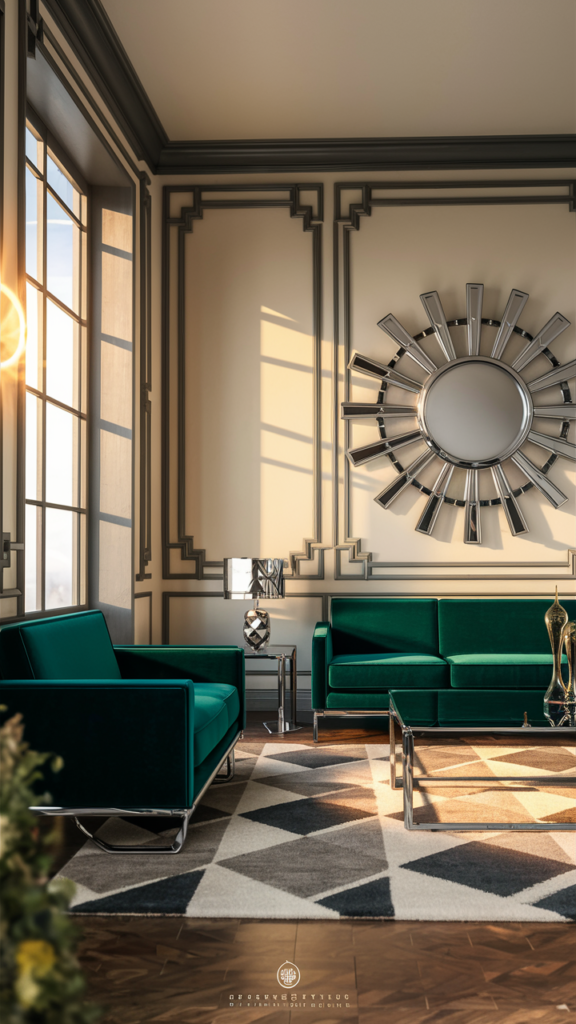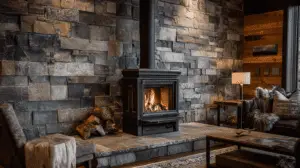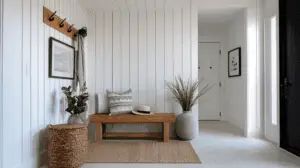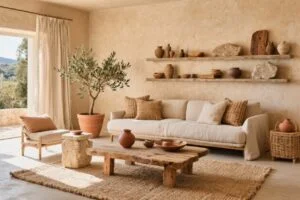Art Deco design brings a touch of glamour and sophistication to any living space, combining sleek lines with luxurious materials. Originating in the 1920s and 1930s, this timeless style is known for its geometric shapes, vibrant colors, and elegant finishes.
Whether you’re looking to add a few Art Deco elements or completely transform your living room, these ideas will inspire you to create a stylish and inviting space. The following ideas will help you understand the key features of Art Deco design and show you how to incorporate them into your living area.
1. Geometric Wallpaper
Geometric wallpaper is a hallmark of Art Deco design. Bold patterns and sharp lines create a sense of sophistication and energy in a living room.
Using geometric shapes like triangles, circles, and zigzags can add a dynamic touch to any wall space. These designs bring visual interest and echo the symmetry found in Art Deco architecture.
For a more subtle look, choose wallpapers with softer colors and smaller patterns. This approach maintains the Art Deco feel without overwhelming the room.
2. Sunburst Mirror
A sunburst mirror is a key feature in many Art Deco living rooms. Its unique design, with radiating lines mimicking the rays of the sun, adds a touch of glamour and sophistication.
These mirrors often serve as a focal point, drawing the eye and creating a sense of space. They can be placed above a fireplace, a console table, or even on an empty wall.
Different sizes and finishes, like gold or silver, allow for versatile use. Pairing a sunburst mirror with complementary lighting, such as candles or wall sconces, enhances its visual impact. It’s a timeless piece that brings both style and character to a room.
3. Ornate Light Fixtures
Ornate light fixtures are a key element in an Art Deco living room. Crystal chandeliers or gold-plated lamps add a touch of elegance. These fixtures often feature intricate designs and geometric shapes.
Wall sconces with stylized patterns like sunbursts or fans can amplify the room’s charm. They also provide soft, ambient lighting.
Table lamps with bold bases and luxurious shades enhance the deco aesthetic. Opt for materials like chrome, glass, or bronze to complete the look.
4. Bold Color Palette
Art Deco design embraces bold and vibrant colors to create a sense of luxury and opulence. Jewel tones like emerald green, sapphire blue, and ruby red are often used to make a statement.
These rich hues can be paired with metallic accents, such as gold and silver, for added elegance. A bold color palette not only adds drama but also highlights the geometric shapes typical of Art Deco style.
Mixing dark shades with lighter neutrals, such as beige or cream, can help balance out the vibrant colors and prevent the room from feeling overwhelming. This combination ensures that the living space remains stylish and inviting.
5. Lacquered Furniture
Lacquered furniture is an iconic element in Art Deco living rooms. These pieces often feature a high-gloss finish that reflects light, adding a sense of luxury and sophistication.
Tables, chairs, and cabinets with lacquered surfaces are common. They not only look sleek but are also durable, maintaining their glossy appearance for years.
Black, white, and bold colors are popular choices for lacquered furniture, working well with the geometric patterns and metallic accents typical of Art Deco design.
6. Vintage Bar Cart
A vintage bar cart can bring both style and function to an Art Deco living room. This piece strikes the perfect balance between elegance and utility, making it a must-have for entertaining guests.
Look for a bar cart with mirrored shelves and brass accents to capture the opulence of the Art Deco era. The mirrors add a touch of glamour while also making the space feel larger.
Incorporate classic cocktail tools and luxurious glassware to complete the look. Mixing old-world charm with modern convenience, a vintage bar cart can be a stunning focal point in your living room.
7. Chevron Patterns
Chevron patterns are a defining element of Art Deco design. These zigzagging lines create a dynamic and visually striking effect in any space.
Using chevron patterns in a living room can add an instant touch of sophistication. They are versatile and can be incorporated into various elements such as rugs, wallpaper, or upholstery.
To keep the look balanced, it’s best to pair chevrons with solid colors or simpler patterns, ensuring that the space doesn’t become too overwhelming.
8. Streamlined Sofas
Streamlined sofas are a hallmark of Art Deco design, characterized by their sleek and elegant lines.
These sofas often feature subtle curves and smooth surfaces that help create a polished look.
Materials like velvet and leather are popular choices for the upholstery, adding a touch of luxury.
Colors often include deep blues, rich purples, and classic black.
Combining these elements can transform any living room into an Art Deco masterpiece.
9. Zebra Print Rugs
Zebra print rugs can bring a touch of wild elegance to an art deco living room. These rugs, with their bold black and white patterns, create a striking contrast against neutral color schemes.
They work well on wooden floors, adding texture and visual interest. Pairing them with metallic accents or mirrored furniture enhances the glamorous feel of the space.
Zebra print rugs also make a smaller room feel chic and stylish. Whether used as a central piece or an accent, they can transform an ordinary living room into a sophisticated retreat.
10. Velvet Cushions
Velvet cushions add a touch of softness and luxury to an Art Deco living room. Their rich texture and vibrant colors can complement the geometric patterns and bold shapes commonly found in this style.
Using velvet cushions on sofas or armchairs can create a cozy yet elegant atmosphere. They are available in a variety of colors, allowing for versatility in design choices.
11. Brass Accents
Brass accents can add a touch of elegance and warmth to an Art Deco living room. They complement the geometric patterns and rich textures typical of this style. Incorporate brass in lighting fixtures, such as chandeliers or floor lamps.
Another way to use brass is in furniture details. Look for coffee tables with brass legs or handles. Even small items like picture frames or vases can make a big impact.
Brass works well with bold colors and plush fabrics often seen in Art Deco interiors. It adds a golden shine that enhances the room’s opulence. Remember, a little goes a long way, so choose pieces that will stand out without overwhelming the space.
12. Tiled Fireplaces
Tiled fireplaces are a great way to add a touch of art deco style to any living room. With their geometric patterns and bold colors, they can make a strong statement. Herringbone tiles, for example, can bring a modern and refreshing twist to a classic design.
Glossy subway tiles in emerald green or navy blue create a vibrant focal point that stands out. Their shiny finish reflects light, making the fireplace area appear brighter and more inviting.
Matte ceramic stones can also be used for a more subdued and sophisticated look. Beige ceramic tiles can give a fireplace an old-world cottage feel, blending vintage charm with modern elegance.
This combination of color, texture, and pattern makes tiled fireplaces a versatile and stylish choice.
13. Art Deco Statues
Art Deco statues add a touch of sophistication and charm to any living room. These sculptures often feature sleek, geometric shapes and figures.
Materials like bronze, chrome, and marble are common in Art Deco statues. They display a mix of modern and classic styles, including human figures, animals, and abstract forms.
Positioning these statues on mantels, shelves, or side tables can create focal points in a room. Their presence adds historical elegance and artistic flair to the space.
14. Decorative Screens
Decorative screens are an elegant addition to any Art Deco living room. These screens often feature intricate geometric patterns, such as trapezoids and zigzags. They reflect the style’s focus on symmetry and bold design.
Using a decorative screen can help define spaces within a room. It can create a sense of privacy without adding walls. Choose screens with metallic finishes or mirrored elements to add a touch of glamour.
Incorporating a decorative screen not only enhances the design but also adds a functional element. It can serve as a focal point, drawing attention to the stylish Art Deco details.
15. Glitzy Chandeliers
Glitzy chandeliers add a touch of luxury to any living room. These lighting fixtures often feature intricate designs, sparkling crystals, and polished metals. They capture the grandeur associated with the Art Deco era.
Using a glitzy chandelier as a centerpiece can elevate the entire look of the room. It draws attention and adds a sophisticated element to the space.
From shimmering crystals to bold metallics, the options are vast. The chandelier not only provides light but also serves as a statement piece, bringing together the glamorous atmosphere typical of Art Deco design.
Understanding Art Deco Design
Art Deco design is known for its bold geometric shapes, rich materials, and luxurious elements. It’s a style that blends innovation with elegance and serves as a fascinating era in art and design history.
Origins and History
Art Deco emerged in the early 20th century, with its roots tracing back to the 1920s and 1930s. The name “Art Deco” comes from the Exposition Internationale des Arts Décoratifs et Industriels Modernes held in Paris in 1925. This style became popular after this exhibition, showcasing modern and innovative art and design.
It reflects the social and political changes of its time, embracing modernism and rejecting the ornate style of the past. It draws influence from various artistic movements such as Cubism, Futurism, and the Bauhaus. The design elements spread internationally, influencing architecture, fashion, interior design, and more during its peak.
Key Characteristics
Art Deco is characterized by its use of geometric shapes, such as zigzags, triangles, and sunburst motifs. These bold shapes create a dynamic and visually striking appeal. The use of luxurious materials like chrome, glass, marble, and exotic woods is prominent.
The color palette often includes black, gold, silver, and rich jewel tones. Furniture pieces typically feature sleek, angular profiles and lavish upholstery. Decorative elements like mirrors, glass, and polished metals add to the opulence.
Lavish use of patterns and symmetry is essential, providing balance and harmony to the design. The emphasis on craftsmanship and attention to detail is evident in every piece, making Art Deco not just a design style but a statement of luxury and modernity.
Incorporating Art Deco in Living Rooms
Incorporating Art Deco in living rooms involves a careful selection of furniture, color schemes, and materials. These choices help create a space that reflects the glamour and sophistication of the iconic Art Deco era.
Furniture Choices
Art Deco furniture often features sleek, curved lines and elegant shapes. Pieces such as mirrored coffee tables, velvet armchairs, and lacquered wood cabinets are popular. Look for pieces with geometric patterns and bold designs. Metallic accents, especially in gold and chrome, add to the luxurious feel. Upholstery should be plush, using fabrics like velvet or leather. The key is to strike a balance between opulence and functionality.
Color Schemes
Typical Art Deco color schemes include rich, bold colors such as navy, emerald green, and deep reds. These are often paired with metallics like gold, silver, or chrome to add a touch of glam. Black and white combinations are also common, often creating a stark, dramatic backdrop. Earth tones, such as beige and cream, can be used to soften the space and add warmth without detracting from the overall style.
Materials and Textures
Materials and textures play a crucial role in defining the Art Deco style. Common materials include polished wood, marble, and chrome. Mirrored surfaces are used to reflect light and add a sense of space. Textiles should be luxurious, with fabrics like velvet, silk, and satin offering rich textures. Incorporate geometric patterns into rugs, cushions, and wallpapers to tie the room together. Bold, sumptuous materials create a stylish and cohesive look that is true to the Art Deco ethos.
Mixing Modern Elements with Art Deco
Integrating modern elements into an Art Deco living room can create a space that feels both classic and contemporary. Key aspects include creating a balance between old and new styles and incorporating bold statement pieces.
Balancing Old and New
Combining modern and Art Deco styles requires careful consideration of both elements. Start with foundational Art Deco features like bold geometric patterns and rich materials. Then, add modern pieces that complement these traditional accents.
For example, an Art Deco rug with a modern sofa can create an interesting visual contrast. Using neutral colors for modern furniture ensures it doesn’t overshadow the more ornate Art Deco designs.
Lighting is another way to blend styles seamlessly. A modern chandelier can add a touch of contemporary flair without detracting from the Art Deco theme. Simply make sure the materials, like chrome or glass, resonate with the overall design palette.
Statement Pieces
Incorporating statement pieces can enhance the Art Deco aesthetic while still feeling fresh and modern. Think of items like a sunburst mirror or a bold, geometric coffee table.
Mirrors with metallic frames can add a touch of glamour and make the room feel larger. A well-chosen piece of wall art can act as a focal point and tie together different design elements.
Sculptural lamps or vases can also bring a modern twist to an Art Deco space. Using luxurious materials like marble or brass can make these pieces stand out even more, blending the old and new seamlessly.
Frequently Asked Questions
These points will help you understand how to bring Art Deco elements into your living room, from selecting key furniture pieces to choosing the right color schemes.
How can I integrate Art Deco style into my modern living room?
You can integrate Art Deco style by incorporating geometric wallpaper and a bold color palette. Ornate light fixtures can add glamour, while lacquered furniture introduces a luxurious touch.
What are key furniture pieces for an Art Deco-inspired living room?
Key pieces include lacquered furniture and geometric-patterned sofas. Bold, high-quality materials such as leather and metal are often used. Consider adding a sunburst mirror for an iconic Art Deco element.
Which color schemes are most representative of the Art Deco period?
Typical color schemes include bold and rich hues like black, gold, silver, and deep jewel tones such as emerald, ruby, and sapphire. These colors enhance the luxurious feel of the Art Deco style.
What are distinctive Art Deco design elements to incorporate in a living room?
Some distinctive elements are geometric wallpaper, sunburst mirrors, and ornate light fixtures. Incorporating bold color combinations and luxurious materials like lacquer and chrome also embodies Art Deco design.
How does Art Deco interior design differ from Baroque and Art Nouveau styles?
Art Deco focuses on geometric shapes, symmetry, and luxury, while Baroque is known for its opulence, curved lines, and elaborate details. Art Nouveau emphasizes organic forms, flowing lines, and natural motifs.
What are some budget-friendly ways to add Art Deco flair to a living room?
Adding Art Deco flair on a budget can involve using bold paint colors, geometric-patterned cushions, and second-hand furniture with ornate detailing. Simple updates like a starburst mirror or metallic light fixtures can also make a significant impact.




